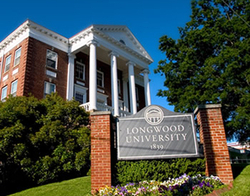
Citing record enrollment, a successful capital campaign and progress keeping more students on track toward a timely degree, Longwood University’s Board of Visitors on Saturday approved the smallest percentage increase in tuition and mandatory fees seen at any Virginia public university in more than a decade.
The 2.1 percent increase in undergraduate in-state tuition and mandatory fees for 2014-15 is the smallest at Longwood in 14 years, and the smallest at any Virginia 4-year public institution since 2001, according to annual tuition and fee reports published by the State Council of Higher Education for Virginia (SCHEV).
Over the past decade, tuition and fee increases at Virginia institutions have averaged 7.3 percent annually.
"College is what energizes the American dream, and it is a moral issue that it remain affordable," said President W. Taylor Reveley IV, who took office June 1, 2013. "The rising student loan debt of recent years is unsustainable by students and families. We are choosing a path that’s better for students, and for Longwood: to invest in ensuring that every student who comes to Longwood gets strong support to stay on track and graduate."
Longwood, a public liberal arts university with 4,960 students, celebrates its 175th anniversary this year. It is among the 100 oldest colleges and universities in the nation, and the third-oldest public university in Virginia, following the University of Virginia and the College of William & Mary.
The Board also approved a substantially simplified fee structure that will lower the auxiliary fees paid by most students and direct more of each student dollar to support teaching and other core educational initiatives.
Tuition charges, which by law can only fund educational expenses, will increase 7.4 percent; however, that increase will be largely offset by a 4.9 percent reduction in mandatory student fees, which support areas such as information technology, athletics and student services. These percentage changes will be the same for in-state undergraduates and out-of-state undergraduates.
As part of a simplified fee structure, undergraduate students will pay a standard comprehensive fee per credit hour, regardless of whether the course is delivered on campus, online or at offsite locations.
The change will reduce fees for the vast majority of students, simplify billing and cost planning for families, and provide a fairer means of supporting resources such as information technology that are funded through the comprehensive fees. A small number of traditional students who have elected to take online courses will see their comprehensive fees increase, but for the vast majority, costs associated with these mandatory fees will decline.
In 2014-15, tuition and mandatory fees for in-state undergraduates will be $11,580 per year, based on a full course load of 30 credits. The comparable cost for out-of-state undergraduate students will be $25,350. The Board will set prices for graduate students at a later date.
Improving students’ pathways to graduation has been a key focus of both state and federal policymakers in recent years, and Reveley has made it his highest priority.
In particular, he has focused on the targeted use of technology and "big data" to reinforce Longwood’s strong culture of personalized student support ‑ for instance, by more effectively identifying students at academic risk, deploying resources to support them and ensuring their course selections are moving them efficiently toward a degree.
In November, Reveley hired Longwood’s first vice president of strategic operations, Victoria Kindon, an expert with substantial experience putting data to use in the nonprofit, corporate and political sectors. Kindon’s division oversees departments including admissions, financial aid, academic and career advising, and information technology.
Reveley said the delayed state budget is a concern to everyone in Virginia public higher education, but that Longwood is already seeing results from its retention focus. He said it was important to send a message to families making college plans for next year.
"Longwood is on the rise," Reveley said. "We’ve recently completed a $41 million capital campaign. Enrollment is at a record high. Applications are up for next year, big data is helping us strengthen our operations, and we are confident that our focus on retention will pay off both for our students and the institution." Last fall, Longwood received an A1 bond rating from Moody’s ‑ reflecting a level of financial strength enjoyed by only 10 percent of U.S. colleges and universities.
"Considering the range of services students enjoy at institutions like Longwood, there are good reasons college costs more today than in the past," said Marianne Radcliff, Rector of the Board of Visitors. "But we are focused on the role of college ‑ and Longwood ‑ in society. Costs can’t continue to increase in the coming decades the way they have in recent decades. Focusing on retention is the right thing for students, for taxpayers, and for Longwood itself, to make sure we can financially support the hands-on teaching and residential learning experience that has been our hallmark for 175 years."
Founded in 1839, Longwood is dedicated to the development of citizen leaders who are prepared to make positive contributions to the common good of society. It enjoys the highest percentage of courses taught by full-time professors of any of the designated public universities in Virginia.
Longwood is organized into five colleges: the Cook-Cole College of Arts and Sciences, the College of Business and Economics, the College of Education and Human Services, the Cormier Honors College, and the College of Graduate and Professional Studies. Longwood’s athletic teams compete at the NCAA Division I level, and the university is a member of the Big South Conference.
For more information on 2014-15 tuition and mandatory fees, visit: Longwood Student Accounts

